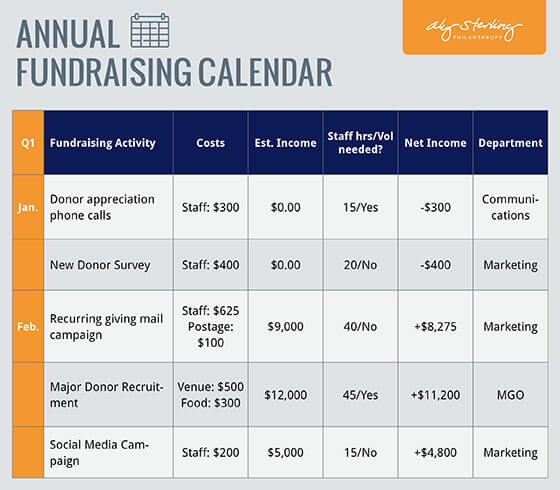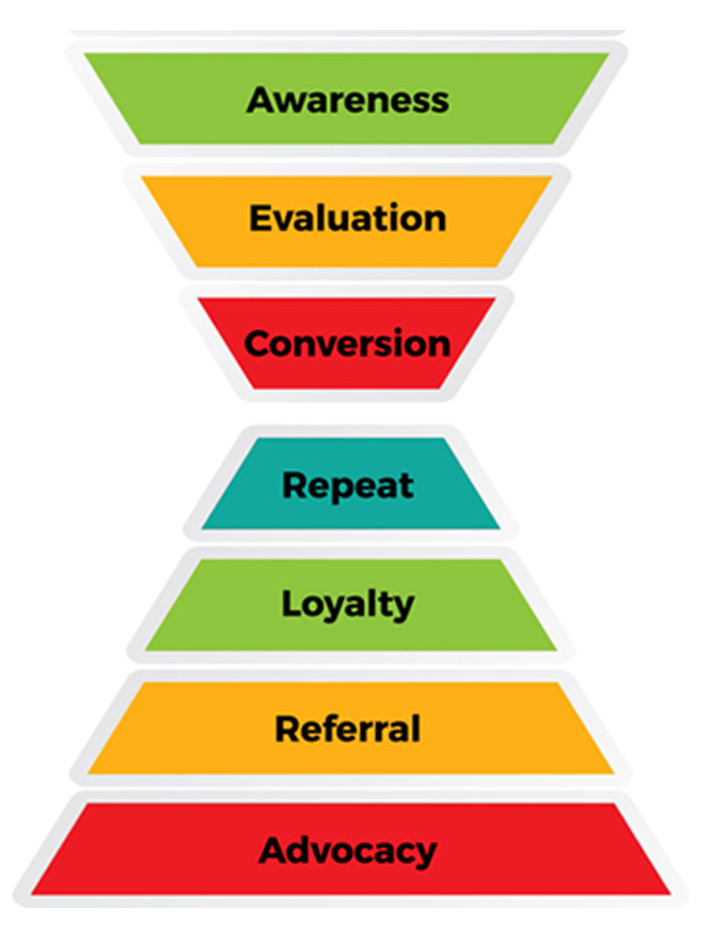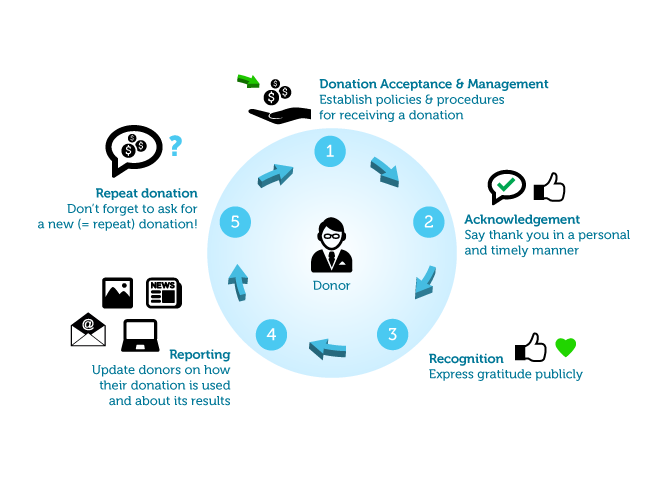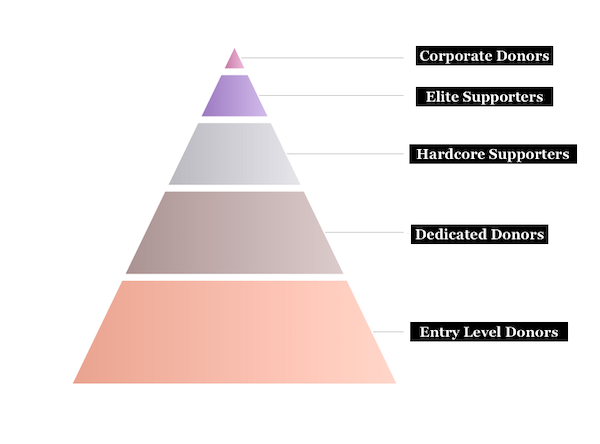Part
01
of one
Part
01
Foundation Fundraising
Key Takeaways
- Of the five charities examined (The Nature Conservancy, Alzheimer's Association, Scholarship America, Catholic Relief Charities, and Covenant House) all except for the Alzheimer's Association had at least one year in the five most recent years reported where donations were down compared to the previous year.
- Six best practices for fundraising for nonprofits are to prioritize recurring donations, personalization, create a fundraising strategy and establish tracking, peer fundraising, impact statements, and donor care.
- The retention rate for recurring donors was 90%, compared to 46% for non-recurring givers, which shows the importance of prioritizing current donors through an outreach or stewardship program.
- In 2019, 26% of online donations were made through mobile devices, which means that optimizing donation forms for mobile is a critical component for increasing donations.
Introduction
This research begins with a look at five of the charities identified by Forbes as being a top 100 charity for 2020, based on private donations raised. For each charity included, an analysis of private contributions for the last five years has been provided in the attached spreadsheet, and examples of the fundraising campaigns for each are provided below.
The research continues by identifying six best practices for nonprofit fundraising from those suggested by various experts in the space. Each practice is described, and there are examples given of at least one charity that has utilized the practice.
Finally, the typical steps of the donation funnel are defined and described, along with tips for maximizing the effectiveness of each step. The steps in the funnel are awareness, evaluation, donation, and post-donation.
Top US Charities
- In December 2020, Forbes published a list of America's Top Charities, which identified the top 100 charities based on the amount of private donations received. The top 10 are United Way, Feeding America, Direct Relief, Salvation Army, St. Jude Children's Research Hospital, Habitat for Humanity, YMCA, Compassion International, Boys & Girls Club of America, and Goodwill Industries.
- The attached spreadsheet has the percentage change in donations for five charities for the most recently available 5-year span (typically from 2016 through 2020). For Covenant House, only five years of Form 990 were found so there are only percentage change calculations for four periods.
- To calculate the private contributions for each charity, we utilized the numbers on Part VIII (Statement of Revenue) of the 990 forms. For consistency across years and charities, contributions were calculated as follows:
- Total private contributions = private total contributions, gifts, grants and other similar amounts (line 1h) - government grants (line 1e)
- All calculations can be seen in the cells of the spreadsheet.
- Following are at least two examples of successful campaigns for each of the foundations/nonprofits in the spreadsheet.
The Nature Conservancy
- Wisconsin's Path was launched in 2017 with the goal of protecting the lands and waters in the state. Reporting indicates that after four years, the campaign has "raised more than $65 million in gifts for today and legacy gifts for tomorrow."
- The "Michigan - It's Our Nature" campaign raised over $100 million in six years.
Alzheimer's Association
- The Walk to End Alzheimer's is a top initiative for the Alzheimer's Association. As can be seen from the data shared by the association, the top 30 walks raised from about $200,000 to $450,000 each in 2021. This was a significant decline from 2020 when the range for the top 30 walks was about $400,000 to $1.5 million each.
- The Longest Day is another campaign by the Alzheimer's Association. Reporting in 2019 stated that there had been over $455 million in donations for the campaign.
Scholarship America
- In 2021, Scholarship America raised over $905,000 at its Dreams to Success event. The event was held virtually in both 2020 and 2021.
- The Dollars for Scholars program localizes fundraising through local chapters that focus on the local community. The program has been around for over 25 years and there are close to 500 chapters nationwide.
- Please note that Forbes states that private donations for this foundation were $207 million for 2020. While the financial reporting for 2020 was not available for us to examine, the previous years show much lower amounts of private donations, with no year even reaching $25 million. However, since this didn't impact being able to show the change in donations through the years or examples of campaigns, it has still been included.
Catholic Relief Services (CRS)
- CRS Rice Bowl is a program that runs during Lent and allows families to give donations while also praying and fasting for those who are hungry. More than $250 million was raised in the first 40 years of the program, and "nearly 14,000 Catholic parishes and schools across the U.S. participated in" 2019.
- In early 2020, CRS launched "Lead the Way on Hunger," a program aimed at getting Catholic communities across the US to engage on the issue of global hunger. This is a multiyear campaign and no data was found on how much money has been raised so far.
Covenant House
- The Sleep Out event is an annual fundraiser for Covenant House that involves sleeping outside to raise funds to help homeless kids. Although overall numbers were not found, in 2020 Covenant House Illinois raised over $300,000 through its Sleep Out events.
- Additionally, the foundation offers a variety of ways for donations to be made including monthly giving, donations in lieu of gifts for loved ones, employer matching, AmazonSmile, eBay for Charity, and more.
- Of note, the total private contributions we calculated are considerably lower than the number provided by Forbes. However, as with Scholarship America, we were still able to show year-over-year changes and provide campaign examples, so it was included.
Best Practices (describe, why included, company examples)
Suggest and Prioritize Recurring Donations
- Since recurring donors will generally be some of the highest overall givers to an organization, nonprofits should focus on turning one time givers into recurring givers. Additionally, the retention rate for recurring donors was 90%, compared to 46% for non-recurring givers.
- There are several ways to encourage this type of giving: (1) highlight it on any donation forms; (2) make recurring donations the default option; and (3) make it easy for donors to choose this option.
- With statistics showing that 81% of first-time donors never donate again, automating the process of sending thank you letters will lower the drop-off rate and potentially convert these one-time donors into recurring donors.
- The Obama Foundation prioritizes recurring gifts by putting in on the left of their page, where most people will look first due to reading left to right. The WWF also highlights monthly donations by having it at the top of their giving page.
Personalization
- Donors are different which means that the types of appeals that will work for each are also different. By understanding who current and potential donors are, foundations can target each group with more appropriate messaging.
- Some more common ways to segment donors are through demographics, giving level, supporter type, length of relationship, geographic location, and priority projects.
- One report from Accenture found that "44 percent of donors are willing to donate up to ten percent more upon receiving an 'individualized experience' as opposed to mass-marketed communications." Additionally, 69% of Us respondents in one survey indicated that a personalized experience was important.
- Three examples of nonprofits that have effectively used personalization to improve results are The Truth Initiative, the American Cancer Society, and Charity: Water.
Set Goals and Track KPIs
- One of the most important steps any nonprofit needs to take in order to improve their fundraising is to have goals and create a plan, or fundraising strategy, to meet those goals.
- The plan should be written out to keep everyone focused on the areas that will bring in the most revenue. There are many free templates available for creating a plan, but some of the primary elements that need to be included are an executive summary, organizational structure, strategic objectives, timeline, budget, and marketing. While simplified, the example below shows one way this data may be organized, as well as the detail needed.
- Additionally, the goals set need to be trackable, and key performance indicators (KPIs) should be selected that allow organizations to measure the success of their fundraising. Common KPIs for nonprofits to measure related to fundraising are average donation size, number of recurring donors, online versus offline giving, and new donor acquisition rate.
- While we were not able to find any examples of fundraising plans published by nonprofits, the American Heart Association allows donors to create their own fundraisers and takes them through the steps to do that successfully. This could be seen as the organization helping the donor create their own plan.
Peer-to-Peer Fundraising
- Peer fundraising has become much more common as organizations have discovered that by having people who already support the charity share with their friends and family, grassroots support can be increased, and they can reach people they may not have previously had access to.
- These types of campaigns most often happen over social media. Facebook reported in 2019 that $1 billion had been raised on its platform as the result of birthday fundraisers.
- These types of fundraisers utilize the concept of social proof, which says that people are more likely to pay attention to something when it is shared by a peer.
- Our research found that almost all charities we looked at offer options for peer fundraising, but some specific examples of companies that have been particularly successful are RAICES (raised over $20 million), "St. Jude, the Alzheimer’s Association, the American Cancer Society, Share Our Strength—No Kid Hungry and the ASPCA."
Impact
- Of all the best practices included in this report, utilizing impact statements was the only one that was recommended in all five of our core sources.
- According to Cathexis, including impact descriptions on the donation page may "drive higher gifts because they’re choosing an amount based on the impact they can create, rather than an arbitrary dollar amount."
- Neon One reports that using "emotionally-compelling images" can show potential donors the impact their money will have, and encourage higher donations.
- This donation page from Fresh Roots shows potential donors exactly what the various donation amounts will supply,
- This infographic from Biola details how much money was raised, and how that translated into concrete benefits for students.
Care for Donors
- Once someone has chosen to give to an organization, it is important to nurture that relationship to hopefully turn them into recurring donors. At the most basic level this means thanking donors.
- While letters are a great start, having a donor recognition program allows organizations to call out people who are supportive of the charity, and many donors love that type of attention.
- According to Network for Good, the five stages of donor stewardship are gift acceptance, acknowledgment, recognition, communicating results, and cultivation. Nonprofits need to have plans in place for each of these steps to ensure they are happening in a timely manner.
- Studies have shown that the cost of acquiring new donors may be 50-100% more than the donation they make, resulting in a loss for the charity. However, if they can be turned into a recurring donor, that can be turned around.
- CuriOdyssey implemented a donor engagement strategy at the end of the year which resulted in a 21% increase in year-end giving.
Donor Funnel
The donor funnel is widely accepted to be the process that potential donors follow to become donors of a given organization. However, there is disagreement on how many, and what, those steps are. Below are several examples of donor funnels from reputable organizations:
- While the terminology and the size of the "funnels" may vary, the main components and focus are generally the same across the examples found. Based on a review of the above images and many more found in the course of the research, we have focused on four main steps of the funnel: awareness, evaluation, donation, and post-donation.
Awareness
- During this stage of the funnel (or customer journey), potential donors are not yet aware of an organization, or may have just become aware, but the charity realizes (through data collection and analyzing) that they fit the profile of a donor. Therefore, it is the job of the charity to make the potential donor aware of them and what they do. This can also be called the prospect stage.
- Content marketing is a great strategy at this stage, as it is informative, and does not focus on turning people into immediate donors. This is a low pressure way for people to learn about a charity. This could occur through blogs, articles, social media, and paid ads.
- For people that have entered a charity's funnel (website visit, live event, etc), the goal is to continue to build awareness and to educate potential donors about what the nonprofit is and what its mission is.
- It is important to use a variety of platforms to reach potential donors as well. This could include display ads, video, Google Ads, radio and connected TV.
Evaluation
- The evaluation, or research, phase, is where potential donors actively attempt to learn more in order to determine if they want to support a given charity. It is in this phase that they may visit the nonprofit's website. It is important that the website is optimized, engaging, and that the focus is on the important information that people need to know, such as accomplishments and mission.
- More specifically, the website should highlight success stories, use infographics to show important metrics, provide transparency about where donations go (including financial reports), and testimonials from both donors and people who were helped.
- Videos are also a good tool here because they can be engaging and elicit emotion. Ultimately, what will draw people in is good stories that demonstrate how their money will do good in the world.
- Charity Navigator provides a road map for people looking to donate. They recommend that a charity's finances should be examined, that they have processes in place for accountability and transparency, and that they speak to the charity about its accomplishments and challenges. Being proactive to ensure that taking these steps are easy for potential donors can go a long way toward moving them to the next stage of the funnel.
- Nonprofits who are able to build relationships with potential donors at the evaluation stage, may find they have more success at turning them into donors. Empathy is one of the key components of relationship building.
Donation
- The donation stage is exactly what it sounds like - the time when a potential donor becomes a donor. However, they can still be lost at this point if the process of giving is not simple. Multiple experts agree that to encourage donations, especially online donations, the process needs to be intuitive and simple.
- The first critical piece at this stage is ensuring that donors can easily find the link to donate. If they have to search too long, they may just give up. Additionally, make sure that when they do click on the link, they are directed straight to the donation page, with no stops in between.
- When designing an online giving form, organizations need to consider how it would be viewed by someone who has never seen it before, and whether it is clear how to go through the process. One recommendation is that the whole process should not take more than two minutes.
- In terms of design, it should be easily readable without zooming, and the font should be large and easy to read. It is also critical that it is optimized for mobile devices, as in 2019 26% of online donations were made through mobile devices.
- When it comes time to actually pay, make sure that there are enough payment options to appeal to a broad audience. When the confirmation of payment is received by the donor, this is also a good opportunity to begin the post-donation phase by outlining other ways they can get involved with the organization.
Post-Donation
- The post-donation phase encompasses several parts of the donor journey, including retention, donor care, and encouraging repeat donations.
- Ideally, once someone has become a donor, the goal is to keep them involved and encourage repeat donations. The cycle may look something like this:
- Most nonprofits would like to have a fundraising pyramid where they move some entry level donors up the pyramid.
- Most of what happens in this phase of the funnel really comes down to how donors are cared for after their first donation is made. An effective strategy for ensuring this is made a priority is to hire a donor engagement officer. This person's job could include creating a plan for engagement, identifying segments of donors, and developing a stewardship strategy.
- Technology is one of the most important tools for donor engagement, at all phases of the funnel, so ensuring that technology is working as it should be is critical. Nonprofits have generally been slow adopters of technology, so those that do make tech a priority can make themselves stand out from other organizations competing for limited donation dollars. Examples of technology tools that may help a nonprofit stand out are text-to-donate options and a donation app.
Research Strategy
For this research on foundation fundraising, we leveraged the most reputable sources of information that were available in the public domain, including Forbes, ProPublica, and the websites of individual nonprofits such as The Nature Conservancy and Scholarships America.
For the specific research on best practices, since there was a great deal of data available on suggested practices for nonprofits, we needed to find a way to ensure that we were including the best practices, as well as those that have the potential to have the biggest impact. To do this, after our initial search, we narrowed down the sources to focus on five companies that have a great deal of experience in fundraising for nonprofits. These are Givebutter (raised millions for causes at more than 300 college campuses), Neon One (over $14 billion raised through their platforms), Salsa (used by more than 3,000 nonprofits), donorbox (used by more than 50,000 organizations and raised over $900 million), and Cathexis Partners (served over 1,000 clients in 13 years). By utilizing curated lists of best practices from each of these companies, we selected the practices that were included most often and that could be further verified with other sources. Through this process we identified the six best practices included above.








